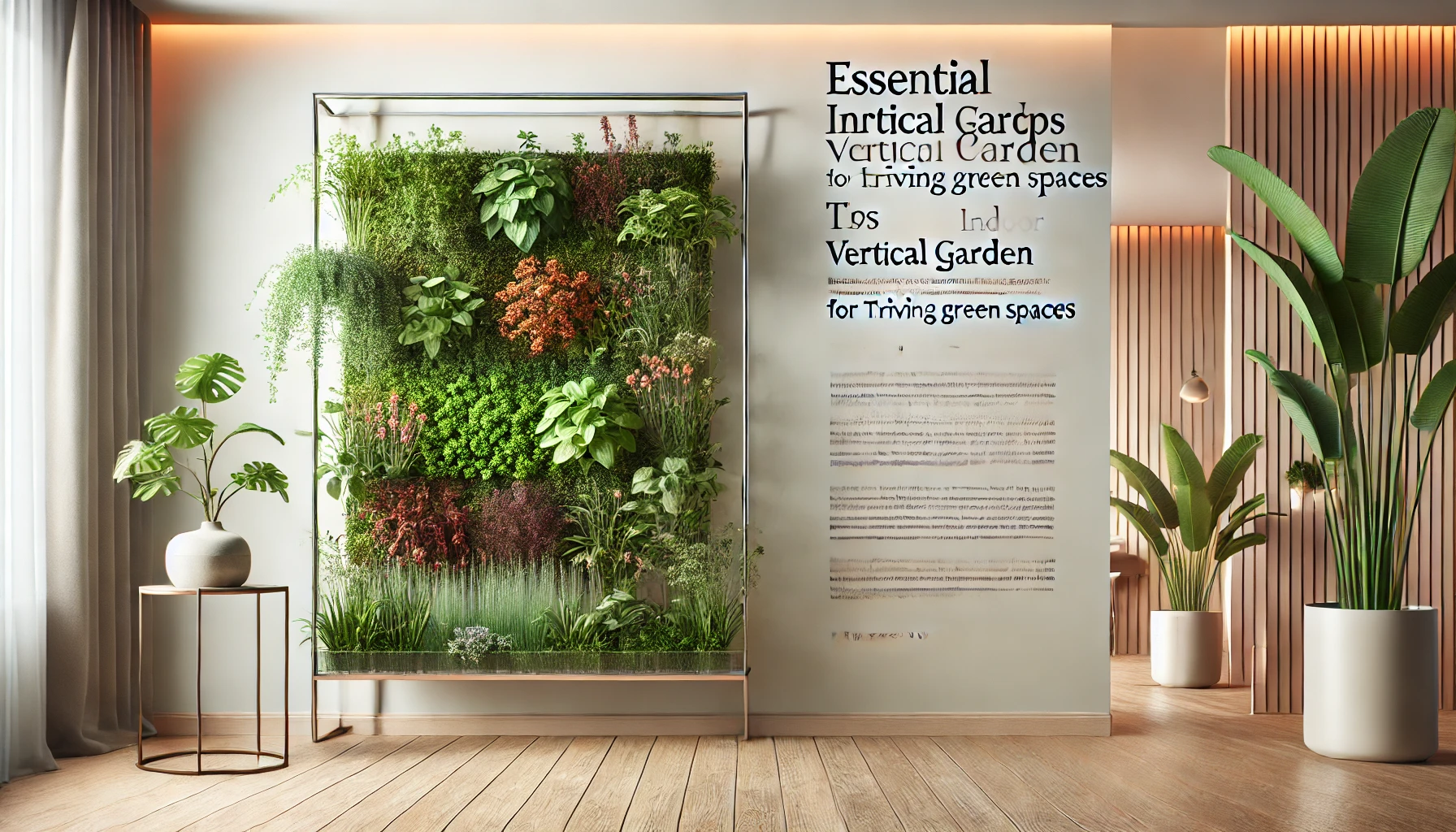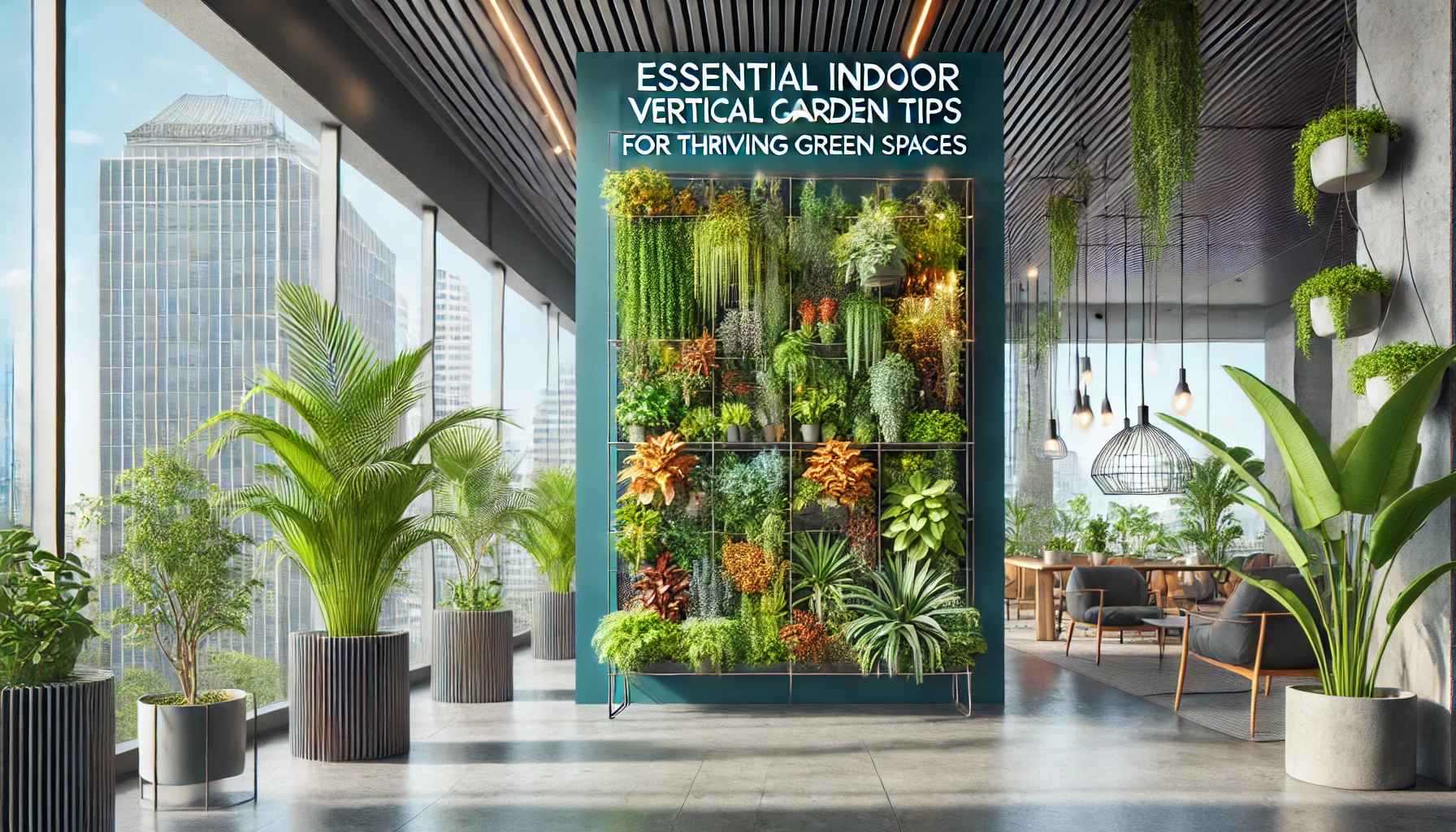Creating an indoor vertical garden is a fantastic way to bring greenery into your home, maximize limited space, and enhance your living environment.
In this blog, we’ll explore indoor vertical garden tips and dive into DIY methods, hydroponic systems, beginner-friendly strategies, space-saving ideas, suitable plants, and more.
Whether you’re a gardening novice or a seasoned green thumb, this guide will help you create the perfect indoor oasis.
DIY Indoor Vertical Garden Tips
Building an indoor vertical garden doesn’t have to break the bank. Here are some DIY tips to help you get started:
Plan your space by choosing a wall or area with adequate light and measuring the space to determine the size of your garden.
Select materials such as repurposed items like pallets, hanging shoe organizers, or old bookshelves, or purchase wall-mounted planters or build your own with wood and fabric.
Set up irrigation by including a simple drip irrigation system to make watering easier and using a waterproof backing to protect your walls.
Choose the right plants, opting for low-maintenance ones suited for indoor conditions. Add personal touches by incorporating decorative elements like fairy lights, colorful pots, or artwork.
Indoor Vertical Garden Hydroponics
Hydroponic systems are an efficient way to grow plants without soil, making them ideal for vertical gardens. Here’s how to integrate hydroponics into your setup:
Understand the basics of hydroponics, which uses nutrient-rich water instead of soil, with systems including NFT (Nutrient Film Technique), deep water culture, and wick systems.
Set up your system using vertical hydroponic towers or wall-mounted systems and install a pump to circulate water and nutrients.
Choose hydroponic plants such as herbs (basil, mint, parsley), leafy greens (lettuce, spinach), and strawberries. Monitor and maintain the system by testing pH and nutrient levels regularly and replacing water every 2-3 weeks to prevent algae buildup.
Experiment with advanced hydroponic techniques like aeroponics, which delivers nutrients directly to roots via mist, and consider hydroponic vertical gardens on a budget using affordable materials like PVC pipes and DIY containers.
Indoor Vertical Garden Tips for Beginners
Starting an indoor vertical garden can seem overwhelming, but these beginner-friendly tips will set you up for success:
Start small by beginning with a compact vertical garden to learn the basics and using easy-to-grow plants like pothos, philodendrons, or succulents.
Focus on lighting, ensuring your plants receive adequate natural or artificial light, and consider grow lights if your space lacks sufficient sunlight. Learn proper watering techniques, avoiding overwatering by checking the soil or water reservoir before adding more.
Stay organized by labeling your plants to track their needs and creating a care schedule to stay consistent. Be patient, as gardening takes time, and don’t get discouraged by slow growth or initial mistakes.
Engage with online forums or local gardening clubs for support and advice. Experiment with different plants and techniques to find what works best in your environment.
Vertical Garden Ideas for Small Spaces
Even in tight quarters, you can create a thriving vertical garden with these ideas:
Use wall-mounted planters by installing a grid or mesh panel to hang small pots. Create hanging gardens by suspending plants from the ceiling using macramé hangers or tiered baskets.
Utilize corners with stackable planters or angled shelves. Attach suction-cup planters to windows for natural light.
Place a ladder against a wall and use the steps to display plants. Invest in modular vertical gardening systems that fit snugly into compact areas. Design vertical gardens that merge with furniture like bookshelves or room dividers for dual functionality.
Create storage spaces that double as plant display areas. Use sleek floating shelves to display plants in modern, minimalist spaces.
Indoor Vertical Garden Plants
Choosing the right plants is crucial for a thriving indoor vertical garden. Here are some excellent options:
Consider low-maintenance plants like pothos, snake plants, and spider plants. Grow herbs such as basil, mint, thyme, and rosemary. Opt for flowering plants like peace lilies, begonias, and African violets.
Choose air-purifying plants like Boston ferns, English ivy, and bamboo palm. Add succulents like jade plant, echeveria, and aloe vera. Incorporate climbing plants like philodendron, ivy, and creeping fig for cascading designs.
Select exotic choices like orchids, bromeliads, and pitcher plants for an eye-catching and unique aesthetic. Include edible plants like strawberries, dwarf tomatoes, and chili peppers. Rotate seasonal blooms to keep your garden fresh and vibrant year-round.
Best Indoor Vertical Garden System
Investing in a reliable vertical garden system can save time and effort. Here are some of the best options:
Choose the GreenStalk Vertical Planter, a stackable planter system with built-in watering. Consider WallyGrow Planters, stylish, eco-friendly wall planters. Opt for the Click and Grow Smart Garden, a high-tech system with automated watering and lighting.
Use a Tower Garden, a hydroponic tower ideal for herbs and vegetables. Explore Urban Green Wall Kits, modular systems for customizable designs. Try Living Wall Art Systems, compact kits that turn plants into framed artworks.
Assemble your own DIY Modular Systems using PVC pipes, fabric pockets, or stacked containers. Utilize Smart Gardens with app-connected systems for tailored plant care and remote monitoring. Explore eco-friendly options made from sustainable and recycled materials.
Vertical Garden Indoor Wall
Transforming an entire wall into a vertical garden creates a stunning focal point in any room. Here’s how:
Prepare the wall by ensuring it can support the weight of plants and planters and using waterproof liners to protect the wall. Select modular systems, pocket planters, or hydroponic panels.
Mount planters securely with brackets or screws and arrange plants for a balanced and aesthetic look. Install grow lights to illuminate the entire wall evenly.
Regularly prune, water, and clean to keep the wall vibrant. Incorporate natural elements by adding moss or climbing plants for a seamless green finish.
Frame the wall using reclaimed wood or metal frames to outline the garden for a polished look. Add colorful plants for a visually striking design. Arrange plants in patterns to create unique and artistic displays.
Indoor Wall Garden with Grow Lights
Grow lights are essential for ensuring healthy plants in low-light indoor spaces. Here’s what you need to know:
Choose from types of grow lights like LED, which are energy-efficient and customizable, or fluorescent, which are affordable and widely available. Position lights 6-12 inches from plants and use adjustable fixtures for flexibility.
Provide 12-16 hours of light daily, depending on the plants. Opt for full-spectrum lights to support growth and flowering. Avoid overheating by using lights with built-in cooling. Use timers to automate the light schedule for convenience.
Select grow lights that blend into your décor, like track lights or pendant fixtures. Opt for LED systems to reduce electricity costs. Combine functional and decorative lighting for a tailored aesthetic.

Expanding Your Indoor Vertical Garden: Advanced Strategies
Once you’ve mastered the basics, consider expanding your vertical garden with advanced techniques and features:
Incorporate smart technology like smart irrigation systems to automate watering and sensors to monitor soil moisture, light levels, and humidity.
Experiment with aquaponics by combining fish tanks with vertical gardening for a self-sustaining system where fish waste provides nutrients for plants, and plants filter the water.
Rotate plants based on seasonal light and temperature changes and add insulation or heating mats during colder months.
Create themed gardens like an herb garden for cooking enthusiasts, a flower garden for aesthetic appeal, or a wellness garden with air-purifying plants and calming greenery.
Stack additional layers or panels to increase plant capacity. Design gardens that match your interior décor with customized planters and layouts. Incorporate small fountains or misting systems to enhance ambiance and humidity.
Use multiple walls and large plants to create an immersive green space. Combine rocks, sand, and cascading plants for a tranquil environment.
Benefits of Indoor Vertical Gardens
Indoor vertical gardens offer a range of benefits beyond aesthetics. Here’s why you should consider starting one:
They are space-efficient, ideal for apartments and small homes with limited floor space. Improve air quality by acting as natural air purifiers, reducing toxins, and improving oxygen levels.
Enhance mood and productivity as greenery has been shown to reduce stress and increase focus. Promote sustainability by allowing you to grow your own food or herbs, reducing reliance on store-bought produce.
Provide a creative outlet as designing and maintaining a vertical garden is a rewarding hobby. Offer health benefits, as exposure to plants can improve mental well-being and lower anxiety levels.
Help regulate indoor temperatures, reducing heating and cooling costs. Serve as a stunning centerpiece in any room. Offer therapeutic value, as caring for plants provides a calming, meditative experience.
Troubleshooting Common Issues
Even with the best intentions, indoor vertical gardens can encounter challenges. Here’s how to troubleshoot common problems:
Address pests by identifying and treating infestations with organic sprays or natural predators and maintaining cleanliness to prevent outbreaks.
Adjust watering frequency based on plant needs and environment to avoid overwatering or under-watering and use self-watering systems for consistency.
Supplement natural light with grow lights and rearrange plants to optimize exposure if lighting is poor.
Use quality fertilizers or hydroponic nutrients to address nutrient deficiencies and monitor plant health to adjust feeding as needed.
Regularly check for loose or unstable planters and reinforce supports to handle plant growth and weight. Improve ventilation and avoid overwatering to prevent mold and mildew.
Isolate affected plants and treat diseases with appropriate solutions and remove dead or infected leaves promptly.
Ensure plants have sufficient nutrients, light, and water to thrive if growth is slow. Investigate causes like pests, nutrient imbalance, or lighting issues if leaves discolor.
Conclusion
Creating an indoor vertical garden is a rewarding endeavor that combines creativity, functionality, and nature.
By following these indoor vertical garden tips and exploring various setups, plant choices, and systems, you can transform any indoor space into a lush, green haven.
Start small, experiment with different designs, and enjoy the beauty and benefits of indoor gardening.


The tips shared here are incredibly helpful for anyone looking to create a thriving indoor vertical garden. I love the idea of using modular systems for a customizable look, especially in limited spaces. Hydroponic setups are a great option too, particularly for growing herbs like mint and basil. The benefits go beyond aesthetics, with air-purifying plants improving indoor air quality and contributing to a healthier environment. Overall, this guide offers a wealth of ideas to transform any space into a green oasis with minimal effort and maximum impact!
Thank you so much for your thoughtful feedback! I’m thrilled to hear that you found the tips helpful and inspiring. Modular systems really do offer fantastic flexibility, especially for small spaces, and hydroponics are such a game-changer for growing fresh herbs indoors. It’s amazing how these setups not only enhance the aesthetic but also contribute to better air quality and overall well-being. I’m so glad the guide resonated with you—wishing you all the best in creating your own green oasis!